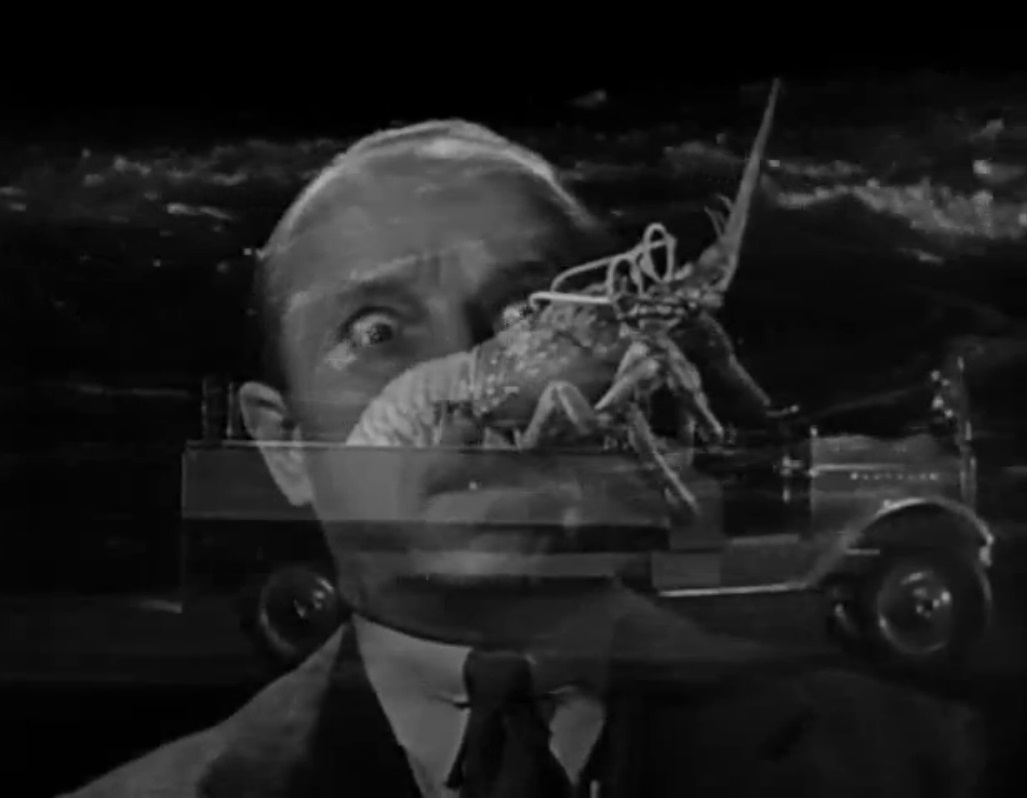The
Saint Strikes Back

A particularly
elegant composition for the well-dressed and well-spoken hero.
A cashiered cop
serves as patsy for an inside caper with a philanthropist as “false front”, the cop’s daughter raises a “hornet’s
nest” in the city for spite.
Bravura opening
at the Colony Club in San Francisco on New Year’s Eve, pivoting on a
popped balloon and a potted assassin.
Frank S. Nugent of the New York Times, “a crisp and baffling melodrama.” Leonard Maltin, “tightly directed.” Catholic News Service Media Review Office, “routine”. TV Guide, “spine-tingling direction”.
Wake
Island
An advance
military outpost on the clipper line is set up in mid-1941 and sustains
repeated Japanese attacks after Pearl Harbor.
The factual
remains of the extraordinary defense are simply presented and with rare wit.
Farrow’s skill is evident in 2400 frames describing a small banquet in
honor of the Jap special envoy en route to his final meeting with
Cordell Hull before the sneak attack, the special envoy talks of peace while
the camera moves from a close-up of his smiling face to positions at the end of
the table and back across concerned looks on the faces of U.S. Navy officers to
the special envoy’s face again, smiling.
Peckinpah
remembers this scene and the Marines at their machine guns in The Wild Bunch.
Commandos Strike at Dawn
“Well, Sir,
your Norwegian brother is ready to be taken into the New World Order,”
says the prominent outspoken Norwegian to his captor about to question him.
The long tracking
shot at the opening is repeated in China, here a village on a fjord at
peace, there a village under bombing (and note in the later film a traveling
matte used to join two halves of this shot, borrowed by Hitchcock for The
Birds).
“They ought
to be handled in a police court,” says the citizen’s wife, meaning
the Germans.
“Finally,
Mrs. Bergesen, the police court will be set up, and the traffic will be
enormous,” a friend replies.
The producers of
this masterpiece were “satisfied with great success”, Louis
Gruenberg wrote the score, and Stravinsky has his Four Norwegian Moods.
China
“The New
World Order of the Imperial Japanese Army and its allies” is cut off at
the pass.
Father Goose (dir. Ralph Nelson) inherits the enigma.
The Hitler Gang
The rest is for
you to discern, Goodrich & Hackett and Farrow take it up to the Night of
the Long Knives and The Great Dictator, an Army plot backed by Big
Business to restore the German state, using any party as a front, with
Schicklgruber earning his pay as a stooge.
A great
masterpiece, one of the greatest in the cinema, and achieved under wartime
conditions even more amazing, one that suffers by no comparison with any
subsequent film, its only diminishment self-admitted, “in every detail it
is true insofar as decency will permit.”
Farrow’s
mobile cranework in long takes is a most remarkable feature. Halliwell’s
Film Guide begins to see the light, criticism generally has not begun to
gauge the work.
Calcutta
CIIAC to
Chungking, over the Hump carrying passengers and freight, variously, after the
war.
It’s
supposed to carry something else, too, the death of a pilot who finds out about
it is a great shock to his colleagues, death by thuggee of all things,
somewhere in Calcutta.
Swell guy, stops
a flight to bring over a crankshaft, that’s how he learns of the loot.
“One-punch”, needs help in a saloon fight.
The Maltese
Falcon is the mainstay of a
complicated analysis, it bothered T.M.P. of the New York Times but he
couldn’t place it, let alone account for it, “a sorry mess
indeed.” Halliwell’s Film Guide reports it as
“simple-minded, but quite good fun,” Time Out Film Guide
“a seasoned programmer”.
Hondo
The bitter
complexities add up to a complete image ably analyzed the following year by
Aldrich in Apache.
Penn finds
himself with a veritable blueprint of Little Big Man as well, though
Farrow lets his excoriating details seethe as drama in an exquisite vision of
life on the frontier.
The Sea Chase
A memory of
Keaton’s The General, a
precursor of Peckinpah’s Cross of
Iron, and an isolation of irreducible experience like John F.
Kennedy’s Profiles in Courage,
this is also a postwar evaluation of wartime policy (like The Man in the Gray Flannel Suit) along
the lines proposed by Robert Lowell. Farrow builds up a convincing picture of
life at sea with myriad scenes and setups, all governed by the moral force of
the principal dilemma, and then he adds another layer with the consul’s
public relations maneuver.
From another
point of view, thematically related to The
Long Voyage Home, Wake of the
Red Witch, and Blood Alley.